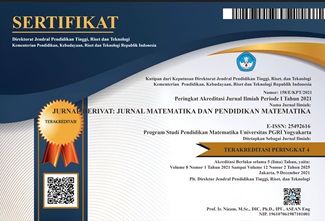Analisis Kemampuan Berpikir Kreatif Matematis Siswa SMP Ditinjau Dari Karakteristik Tanggung Jawab
DOI:
https://doi.org/10.31316/j.derivat.v9i1.2672Abstract
This study is a qualitative descriptive study, which aims to describe the mathematical creative thinking ability of middle school students from the characteristics of high, medium and low students' sense of responsibility. By using purposive sampling technique, the subject of this research consisted of 3 students. Data collection techniques in this study used test and non-test techniques using instruments supporting the characteristics of responsibility, mathematical creative thinking ability test I, interview guidelines, and mathematical creative thinking ability test II. Data analysis in this study includes data reduction, data representation and data conclusions.There are differences in mathematical creative thinking abilities between students with the characteristics of high, medium, and low level student responsibility. Indicators of mathematical creative thinking ability can be achieved by students with high responsibility characteristics. Meanwhile, students with medium and low responsibility characteristics have not been able to achieve the four indicators of mathematical creative thinking.
Â
Keywords: Mathematical creative thinking, responsibility characteristics.
References
Aini, N. N., Sukestiyarno and Waluya, B. (2015) ‘Analisis Komunikasi Matematis dan Tanggung Jawab pada Pembelajaran Formulate Share Listen Create Materi Segiempat’, Unnes Journal of Research Mathematics Education, 4(2), pp. 115–121. Available at: https://journal.unnes.ac.id/sju/index.php/ujmer/article/view/9838.
Andiyana, M. A., Maya, R. and Hidayat, W. (2018) ‘Analisis Kemampuan Berfikir Kreatif Matematis Siswa Smp Kelas Viii Pada Materi Bangun Ruang’, JPMI (Jurnal Pembelajaran Matematika Inovatif), 1(3), pp. 239–248. doi: 10.22460/jpmi.v1i4.p779-784.
Bicer, A. et al. (2020) ‘Considering mathematical creative self-efficacy with problem posing as a measure of mathematical creativity’, Educational Studies in Mathematics.
Dwi Herdani, P. and Ratu, N. (2018) ‘Analisis Tingkat Kemampuan Berpikir Kreatif Matematis Siswa SMP Dalam Menyelesaikan Open – Ended Problem Pada Materi Bangun Datar Segi Empat’, JTAM | Jurnal Teori dan Aplikasi Matematika, 2(1), p. 9. doi: 10.31764/jtam.v2i1.220.
Febrianingsih, F. (2022) ‘Kemampuan Berpikir Kreatif Siswa dalam Memecahkan Masalah Matematis Mosharafa : Jurnal Pendidikan Matematika Mosharafa : Jurnal Pendidikan Matematika’, Mosharafa: Jurnal Pendidikan Matematika, 11(1), pp. 119–130.
Febryana, D. (2018) ‘Profil Kreativitas Siswa dalam Menyelesaikan Soal Segitiga dan Segiempat Ditinjau dari Gender’, Suska Journal of Mathematics Education, 4(1), pp. 50–58. doi: 10.24014/sjme.v3i2.3897.
Hadar, L. L. and Tirosh, M. (2019) ‘Creative thinking in mathematics curriculum: An analytic framework’, Thinking Skills and Creativity, 33(September 2018), p. 100585. doi: 10.1016/j.tsc.2019.100585.
Hastuti, D. D., Sutama and Fuadi, D. (2018) ‘Tanggung Jawab Siswa dalam Pembelajaran Matematika SMA’, Jurnal Managemen Pendidikan, 13(2), pp. 139–146.
Kattou, M. and Kontoyianni, K. (2012) ‘Connecting mathematical creativity to mathematical ability’, ZDM Mathematics Education, 45(2), pp. 167–181. doi: 10.1007/s11858-012-0467-1.
Kuncoro, K. S. et al. (2021) ‘Analisis karakter tanggung jawab ditinjau dari kemampuan awal pemecahan masalah matematika pada pembelajaran pbl’, Jurnal Pengembangan Pembelajaran Matematika (JPPM), 3(2), pp. 1–15.
Leikin, R. and Lev, M. (2012) ‘Mathematical creativity in generally gifted and mathematically excelling adolescents : what makes the difference ?’, ZDM Mathematics Education, 45(2), pp. 183–197. doi: 10.1007/s11858-012-0460-8.
Moma, L. (2015) ‘PENGEMBANGAN INSTRUMEN KEMAMPUAN BERPIKIR KREATIF MATEMATIS UNTUK SISWA SMP’, Delta-Pi, 4(1), pp. 27–41.
Mutia, F. et al. (2018) ‘Analisis hubungan kemampuan berpikir kreatif matematis dan self efficacy siswa smk’, Jurnal Pembelajaran Matematika Inovatif, 1(4), pp. 793–798.
Ni Wayan Ari Suniawati (2021) Pengembangan Instrumen Pengukuran Karakter Tanggung Jawab Pada Para Siswa di SMP Negeri 1 Kuta. UNIVERSITAS PENDIDIKAN GANESHA.
Parandika, R. W., Muhtarom, M. and Sutrisno, S. (2019) ‘Analisis Karakter Disiplin dan Tanggung Jawab Siswa pada Proses Pembelajaran Matematika Kelas XI SMK Palebon Semarang’, Imajiner, 1(6), pp. 364–372. doi: 10.26877/imajiner.v1i6.4866.
Prayogi, A. and Widodo, A. T. (2017) ‘Kemampuan Berpikir Kritis Ditinjau dari Karakter Tanggung Jawab pada Model Brain Based Learning’, Unnes Journal of Mathematics Education Research, 6(1), pp. 89–95.
Robiah, S. et al. (2019) ‘Analisis kemampuan berpikir kreatif matematis siswa smp kelas vii pada materi segitiga dan segiempat’, Journal on Education, 01(03), pp. 460–470.
Sugiyono (2013) Metode Penelitian Kuantitatif, Kualitatif, dan R&D. 19th edn. Bandung: ALFABETA.
Suherman, S. and Vidákovich, T. (2022) ‘Assessment of mathematical creative thinking: A systematic review’, Thinking Skills and Creativity, 44(January), p. 101019. doi: 10.1016/j.tsc.2022.101019.
Syahara, M. U. and Astutik, E. P. (2021) ‘Analisis Berpikir Kreatif Siswa dalam Menyelesaikan Masalah SPLDV ditinjau dari Kemampuan Matematika’, Mosharafa: Jurnal Pendidikan Matematika, 10(2), pp. 201–212. doi: 10.31980/mosharafa.v10i2.892.
Downloads
Published
Issue
Section
Citation Check
License
Authors who publish with this journal agree to the following terms:
-
Authors retain copyright and grant the journal right of first publication with the work simultaneously licensed under a Creative Commons Attribution-ShareAlike 4.0 International License that allows others to share the work with an acknowledgment of the work's authorship and initial publication in this journal.
- Authors are able to enter into separate, additional contractual arrangements for the non-exclusive distribution of the journal's published version of the work (e.g., post it to an institutional repository or publish it in a book), with an acknowledgment of its initial publication in this journal.
- Authors are permitted and encouraged to post their work online (e.g., in institutional repositories or on their website) prior to and during the submission process, as it can lead to productive exchanges, as well as earlier and greater citation of published work (See The Effect of Open Access).







